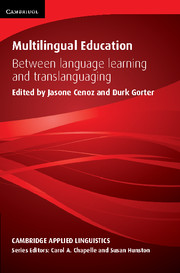Book contents
- Frontmatter
- Contents
- List of contributors
- Series editors’ preface
- Acknowledgements
- 1 Towards a holistic approach in the study of multilingual education
- 2 L1 as a pedagogical resource in building students’ L2 academic literacy: pedagogical innovation in the science classroom in a Hong Kong school
- 3 Linking content, linking students: a cross-linguistic pedagogical intervention
- 4 The role of the native language in the literacy development of Latino students in the United States
- 5 A nexus analysis of code choice during study abroad, and implications for language pedagogy
- 6 Multilingual practices in foreign language study
- 7 Language choices and ideologies in the bilingual classroom
- 8 Communicative repertoires in the community language classroom: resources for negotiating authenticity
- 9 Complementary classrooms for multilingual minority ethnic children as a translanguaging space
- 10 Constructing in-between spaces to ‘do’ bilingualism: a tale of two high schools in one city
- 11 Becoming multilingual and being multilingual: some thoughts
- Index
10 - Constructing in-between spaces to ‘do’ bilingualism: a tale of two high schools in one city
Published online by Cambridge University Press: 17 September 2021
- Frontmatter
- Contents
- List of contributors
- Series editors’ preface
- Acknowledgements
- 1 Towards a holistic approach in the study of multilingual education
- 2 L1 as a pedagogical resource in building students’ L2 academic literacy: pedagogical innovation in the science classroom in a Hong Kong school
- 3 Linking content, linking students: a cross-linguistic pedagogical intervention
- 4 The role of the native language in the literacy development of Latino students in the United States
- 5 A nexus analysis of code choice during study abroad, and implications for language pedagogy
- 6 Multilingual practices in foreign language study
- 7 Language choices and ideologies in the bilingual classroom
- 8 Communicative repertoires in the community language classroom: resources for negotiating authenticity
- 9 Complementary classrooms for multilingual minority ethnic children as a translanguaging space
- 10 Constructing in-between spaces to ‘do’ bilingualism: a tale of two high schools in one city
- 11 Becoming multilingual and being multilingual: some thoughts
- Index
Summary
Introduction
As technology and migration have gone global, multilingualism has become more familiar. It is interesting, however, that our greater awareness of multiple language practices has no correspondence at the societal level, even when educational programmes are organized for immigrants. In the United States, the greater language diversity has led some schools to shed traditional models of bilingual education that had been organized to educate especially the most numerous languageminority group – Spanish-speaking Latinos. This has meant that the bilingual education programmes of the past – both developmental programmes and transitional bilingual education programmes – have been increasingly abandoned, while programmes in which instruction is in English only (self-contained English as a Second Language programmes) have grown. At the same time, however, there are more schools that are being organized to teach two language groups in two languages, leading to the growth of the so-called ‘dual language’ bilingual programmes. What's going on? Are we societally on board with monolingualism or multilingualism? And what is happening in these supposedly monolingual English as a Second Language programmes and bilingual dual language programmes?
This chapter takes the position that language in US education has been, and continues to be, a site of struggle over power and identity. In the twentieth century, the tension was between those who wanted to have bilingual education options and those who insisted that schooling should be in English only. Although this struggle between supporters and critics of bilingual education continues, the tension today is between those who see bilingualism as a commodity that they must have as two separate languages, and those who do bilingualism as bilingual Americans . These two positions, of course, result in different stances towards types of education and pedagogy, as well as theories of what language and bilingualism are. Those who want to have bilingualism because of its societal and market value, most often Anglos who come from monolingual households, insist on programmes that strictly separate languages and insist on bilingualism being two separate languages. That is, bilingualism for them is additive (Lambert, 1975 ) and linear.
- Type
- Chapter
- Information
- Multilingual EducationBetween Language Learning and Translanguaging, pp. 199 - 224Publisher: Cambridge University PressPrint publication year: 2015
- 25
- Cited by



